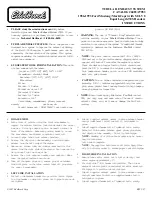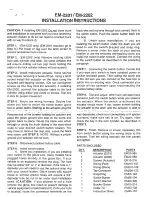
Driving safety systems
72
For more information, see “What to do
if …?” (
Y
page 331).
BAS
G
Observe Safety notes, see
page 70.
The Brake Assist System (BAS) operates in
emergency situations. If you apply the brakes
very quickly, the BAS automatically provides
full brake boost, thereby potentially reducing
the braking distance.
X
Apply continuous full braking pressure until
the emergency braking situation is over.
The ABS will prevent the wheels from
locking.
When you release the brake pedal, the brakes
function again as normal. The BAS is then
deactivated.
G
Warning!
If the BAS malfunctions, the brake system
still functions, but without the additional
brake boost available that the BAS would
normally provide in an emergency braking
maneuver. Therefore, the braking distance
may increase.
Adaptive Brake
Adaptive Brake provides a high level of
braking safety as well as increased braking
comfort. It is coupled with the ABS, the
ESP
®
and the BAS. Adaptive Brake takes
driver and vehicle characteristics into
consideration, thus achieving an optimal
braking effect.
For more information on the brake system,
see (
Y
page 275).
EBP
G
Observe Safety notes, see
page 70.
The Electronic Brake Proportioning (EBP)
enhances braking effectiveness by allowing
the rear brakes to supply a greater proportion
of the braking effort in straight line braking
without a loss of vehicle stability.
G
Warning!
If the EBP malfunctions, the brake system
will still function with full brake boost.
However, the rear wheels could lock up
during emergency braking situations, for
example. You could lose control of the
vehicle and cause an accident.
Adapt your driving style to the changed
driving characteristics.
ESP
®
G
Observe Safety notes, see
page 70.
The Electronic Stability Program (ESP
®
) is
operational as soon as the engine is running
and monitors the vehicle’s traction (force of
adhesive friction between the tires and the
road surface) and handling.
The ESP
®
recognizes when a wheel is
spinning or if the vehicle starts to skid. By
applying brakes to individual wheels and by
limiting the engine output, the ESP
®
works to
stabilize the vehicle. The ESP
®
is especially
useful while driving off and on wet or slippery
road surfaces. The ESP
®
also stabilizes the
vehicle during braking and steering
maneuvers.
The ESP
®
warning lamp
v
in the
instrument cluster comes on when you switch
on the ignition. It goes out when the engine
is running.
The ESP
®
warning lamp
v
in the
instrument cluster flashes when the ESP
®
is
engaged.
Safety and security
Содержание CLK Coupe 320
Страница 1: ...E Class Operator s Manual...
Страница 28: ...Exterior view 26 Exterior view At a glance...
Страница 30: ...Cockpit 28 Cockpit At a glance...
Страница 32: ...Instrument cluster 30 Instrument cluster At a glance...
Страница 34: ...Storage compartments 32 Storage compartments At a glance...
Страница 39: ...Center console 37 Center console Upper part At a glance Z...
Страница 44: ...42...
Страница 80: ...78...
Страница 238: ...236...
Страница 331: ...Vehicle status messages in the multifunction display 329 Practical hints Z...
Страница 395: ...Weights 393 Weights Model All models Roof load max 220 lb 100 kg Technical data Z...
Страница 405: ...403...
Страница 406: ...404...
Страница 408: ...Order no 6515 3416 13 Part no 211 584 86 97 Edition A 2009 2115848697 2115848697...
















































